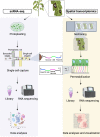Understanding plant pathogen interactions using spatial and single-cell technologies
- PMID: 37542114
- PMCID: PMC10403533
- DOI: 10.1038/s42003-023-05156-8
Understanding plant pathogen interactions using spatial and single-cell technologies
Abstract
Plants are in contact with diverse pathogens and microorganisms. Intense investigation over the last 30 years has resulted in the identification of multiple immune receptors in model and crop species as well as signaling overlap in surface-localized and intracellular immune receptors. However, scientists still have a limited understanding of how plants respond to diverse pathogens with spatial and cellular resolution. Recent advancements in single-cell, single-nucleus and spatial technologies can now be applied to plant-pathogen interactions. Here, we outline the current state of these technologies and highlight outstanding biological questions that can be addressed in the future.
© 2023. Springer Nature Limited.
Conflict of interest statement
The authors declare no competing interests.
Figures


References
-
- Faulkner C, Robatzek S. Plants and pathogens: putting infection strategies and defence mechanisms on the map. Curr. Opin. Plant Biol. 2012;15:699–707. - PubMed
-
- Jones, K. et al. Disruption of the interfacial membrane leads to Magnaporthe oryzae effector re-location and lifestyle switch during rice blast disease. Front. Cell Dev. Biol. 9, 681734 (2021). This article reported that multiple infection phases simultaneously exist in a single rice leaf sheath after inoculation with the fungal pathogen Magnaporthe oryzae. - PMC - PubMed
-
- Daugherty MP, Lopes J, Almeida RPP. Vector within-host feeding preference mediates transmission of a heterogeneously distributed pathogen. Ecol. Entomol. 2010;35:360–366.

